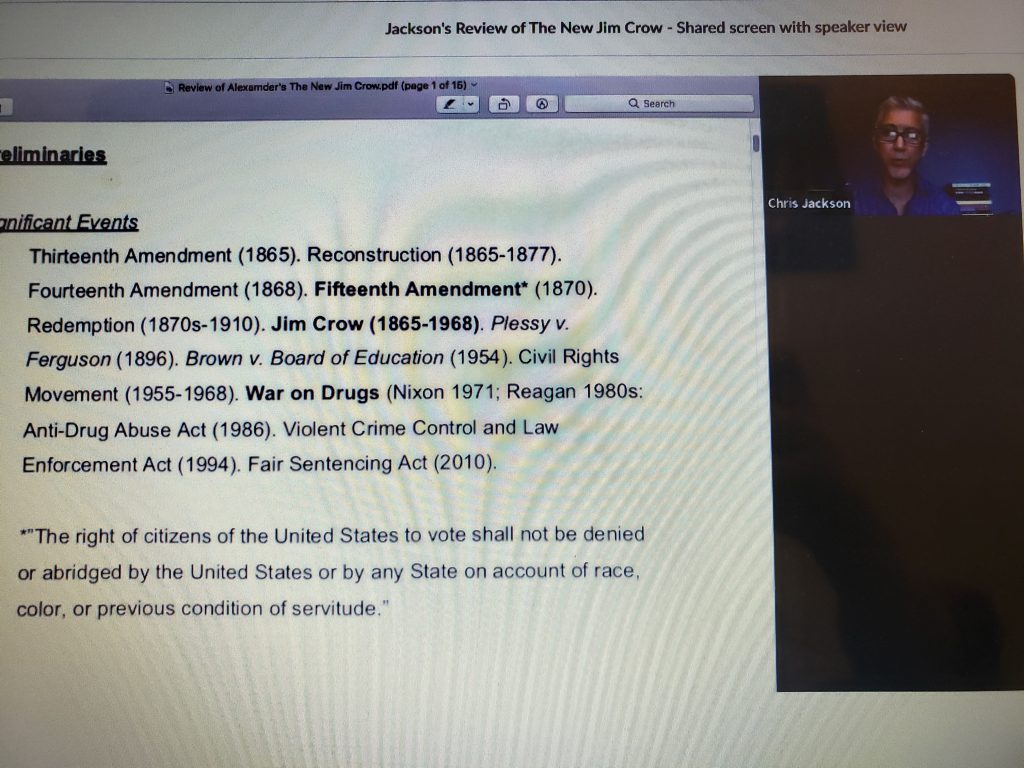CHRIS JACKSON REVIEWS ‘THE NEW JIM CROW: MASS INCARCERATION IN THE AGE OF COLORBLINDNESS’

In an Oct. 28 Zoom webchat, MHCC philosophy and social sciences instructor Chris Jackson gave a review of the 2010 book “The New Jim Crow: Mass Incarceration in the Age of Colorblindness,” written by Michelle Alexander.
Jackson’s interest comes from his summer reading, starting last June: He focused on books and articles about racial justice.
Alexander’s book discusses significant events throughout the 1800s and 1900s with Jim Crow laws (systemic segregation laws that discriminate against African Americans), as well as many other more recent amendments and laws.
The 1896 U.S. Supreme Court case Plessy v. Ferguson initially made racial segregation legal in the U.S., as long as facilities were “separate but equal.”
Most Jim Crow original laws took effect in the 1800s. Key legislation include discriminatory voting laws and punishments associated with crimes. They remained even as the U.S. would determine women’s right to vote, but as time went by, more court cases came to light, and these laws were changed.
A landmark case that began a major change took place at the Supreme Court: Brown v. Board of Education. This 1954 ruling essentially ruled that racial segregation (specifically in public schools) was unconstitutional, overturning Plessy vs Ferguson. Lawyer and civil rights activist Thurgood Marshall, who argued the case, went on to become an associate justice of the Supreme Court in 1967, the first African American member chosen.
Jackson described the events surrounding the events both before and after Brown v. Board of Education, outlined in the book.
“They had a civil rights movement, I have here 1955 to 1968, because that seems to be like the consensus view of this stuff, you know, MLK (Martin Luther King Jr.) and all that – but (President Harry) Truman actually integrated the military” in 1948, he said.
Eventually, in 1968, a federal law for fair housing was enacted. Before, the Civil Rights Act of 1964 and Voting Rights Act of 1965 made huge impacts, during the Civil Rights movement. The Civil Rights Act banned segregation, while the Voting Rights Act took away voting obstacles such as literacy tests that had been required before many Blacks were allowed to vote.
Alexander’s book focuses on the present-day issues of racial inequity (especially in the South) and how laws have reflected this, including new Jim Crow laws that developed, even after the civil rights era.
Jackson said he thought the book was a good read and that it gives a good perspective to this time period in history. He informally gave it a 5 out of 5 rating, in an email shared with MHCC faculty and staff.
There’s also a different side to the book and unforeseen events, he noted. “This book has a lot of parallels (in present times) that are disturbing,” he said.
Jackson has another Zoom book review coming on Nov. 18 around 1 p.m.: “The Diversity Delusion: How Race and Gender Pandering Corrupt the University and Undermine Our Culture,” by Heather Mac Donald.
Mt. Hood students should contact him at [email protected] if interested in attending the sessions, or to access recordings of previous sessions. (He reviewed “White Fragility: Why It’s So Hard for White People to Talk About Racism,” by Robin DiAngelo, on Oct. 7.)

Leave a comment